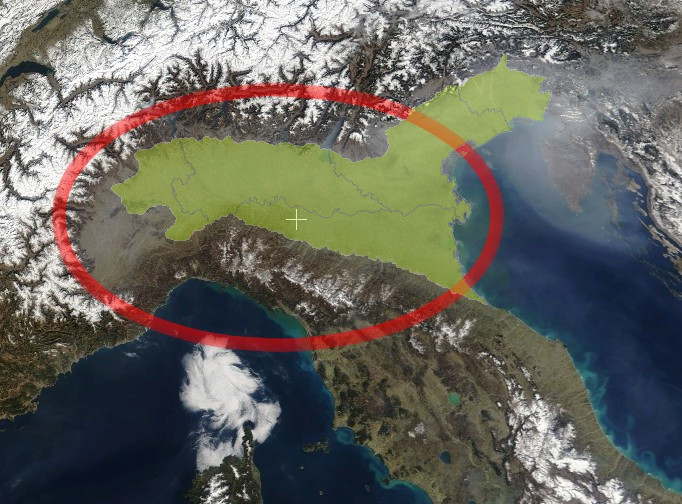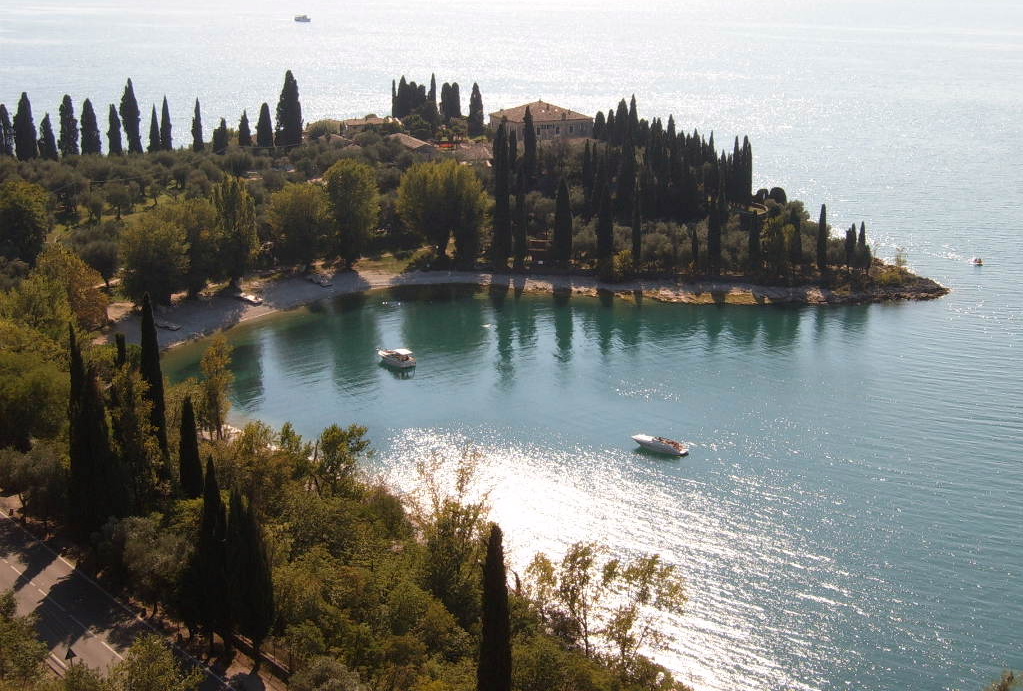|
Lago Di Garda
Lake Garda ( it, Lago di Garda or ; lmo, label=Eastern Lombard, Lach de Garda; vec, Ƚago de Garda; la, Benacus; grc, Βήνακος) is the largest lake in Italy. It is a popular holiday location in northern Italy, about halfway between Brescia and Verona, and between Venice and Milan on the edge of the Dolomites. Glaciers formed this alpine region at the end of the Last Glacial Period, last ice age. The lake and its shoreline are divided between the provinces of Province of Brescia, Brescia (to the south-west), Province of Verona, Verona (south-east) and Trentino (north). Etymology In Roman times the lake was known as ''Benacus'' and by some it was revered as god Benacus, the personification of the lake, sometimes associated with the cult of Neptune. Today it is better known as Lake Garda, a toponym of Germanic origin attested since the Middle Ages and deriving from that of the Garda, Veneto, homonymous town on the Veronese shore of the lake, which, together with anothe ... [...More Info...] [...Related Items...] OR: [Wikipedia] [Google] [Baidu] |
Manerba Del Garda
Manerba del Garda is a town and ''comune'' in the province of Brescia, in Lombardy. It is located at the southwest side of the Lake Garda. It is bounded by the comunes of San Felice del Benaco, Puegnago sul Garda, Moniga del Garda, Polpenazze del Garda and Soiano del Lago. Manebra del Garda is divided into the seven hamlets of Solarolo, Montinelle, Balbiana, Pieve, Trevisago, Campagnola and Gardoncino. History Manerba was founded, according to the legend, in devotion to the goddess Minerva. Other historians trace the name to the Gauls Cenomani, stemming from the union of the terms ''mon'', leader, and ''erb'', a military zone, identifying Manerba as residence of the chief of the tribe. A charter of Frederick II dating from 1 November 1221 mentions the territory surrounding the ancient Church of Manerba as ''Tenense'', whence its current name, Valtenesi. [...More Info...] [...Related Items...] OR: [Wikipedia] [Google] [Baidu] |
Pianura Padana
The Po Valley, Po Plain, Plain of the Po, or Padan Plain ( it, Pianura Padana , or ''Val Padana'') is a major geographical feature of Northern Italy. It extends approximately in an east-west direction, with an area of including its Venetic extension not actually related to the Po river basin; it runs from the Western Alps to the Adriatic Sea. The flatlands of Veneto and Friuli are often considered apart since they do not drain into the Po, but they effectively combine into an unbroken plain, making it the largest in Southern Europe. It has a population of 17 million, or a third of Italy's total population. The plain is the surface of an in-filled system of ancient canyons (the "Apennine Foredeep") extending from the Apennines in the south to the Alps in the north, including the northern Adriatic. In addition to the Po and its affluents, the contemporary surface may be considered to include the Savio, Lamone and Reno to the south, and the Adige, Brenta, Piave and Tagliam ... [...More Info...] [...Related Items...] OR: [Wikipedia] [Google] [Baidu] |
Alps
The Alps () ; german: Alpen ; it, Alpi ; rm, Alps ; sl, Alpe . are the highest and most extensive mountain range system that lies entirely in Europe, stretching approximately across seven Alpine countries (from west to east): France, Switzerland, Italy, Liechtenstein, Austria, Germany, and Slovenia. The Alpine arch generally extends from Nice on the western Mediterranean to Trieste on the Adriatic and Vienna at the beginning of the Pannonian Basin. The mountains were formed over tens of millions of years as the African and Eurasian tectonic plates collided. Extreme shortening caused by the event resulted in marine sedimentary rocks rising by thrusting and folding into high mountain peaks such as Mont Blanc and the Matterhorn. Mont Blanc spans the French–Italian border, and at is the highest mountain in the Alps. The Alpine region area contains 128 peaks higher than . The altitude and size of the range affect the climate in Europe; in the mountains ... [...More Info...] [...Related Items...] OR: [Wikipedia] [Google] [Baidu] |
Colline Moreniche Del Garda
''Colline'' is a 1929 novel by the French writer Jean Giono. It has also been published as ''Hill of Destiny''. It tells the story of a small hamlet in Provence where the superstitious residents struggle against nature, as their settlement is struck by several misfortunes. ''Colline'' was Giono's debut novel. It is the first installment in the author's Pan trilogy; it was followed by the standalone novels '' Lovers are Never Losers'' and ''Second Harvest''. Plot A wild boar enters a village by the Lure mountain range. The villagers try to kill the boar but it manages to escape. The local spring goes dry which causes unrest. At the same time, the bedridden, paralysed village elder Janet begins to speak incomprehensibly. Other misfortunes follow, including a devastating forest fire, and the villagers begin to suspect that Janet is the source of the problems. In hope that it will end the misfortunes, the villagers agree that they should kill Janet. Just before they kill him, though, ... [...More Info...] [...Related Items...] OR: [Wikipedia] [Google] [Baidu] |
Jezioro Garda - Widok Z Alp
Jezioro (meaning "lake" in Polish) may refer to the following villages: * Jezioro, Lower Silesian Voivodeship (south-west Poland) * Jezioro, Lublin Voivodeship (east Poland) * Jezioro, Masovian Voivodeship (east-central Poland) * Jezioro, Silesian Voivodeship (south Poland) * Jezioro, Warmian-Masurian Voivodeship (north Poland) {{geodis ... [...More Info...] [...Related Items...] OR: [Wikipedia] [Google] [Baidu] |
Celts
The Celts (, see pronunciation for different usages) or Celtic peoples () are. "CELTS location: Greater Europe time period: Second millennium B.C.E. to present ancestry: Celtic a collection of Indo-European peoples. "The Celts, an ancient Indo-European people, reached the apogee of their influence and territorial expansion during the 4th century bc, extending across the length of Europe from Britain to Asia Minor."; . " e Celts, were Indo-Europeans, a fact that explains a certain compatibility between Celtic, Roman, and Germanic mythology."; . "The Celts and Germans were two Indo-European groups whose civilizations had some common characteristics."; . "Celts and Germans were of course derived from the same Indo-European stock."; . "Celt, also spelled Kelt, Latin Celta, plural Celtae, a member of an early Indo-European people who from the 2nd millennium bce to the 1st century bce spread over much of Europe."; in Europe and Anatolia, identified by their use of Celtic langu ... [...More Info...] [...Related Items...] OR: [Wikipedia] [Google] [Baidu] |
Lombards
The Lombards () or Langobards ( la, Langobardi) were a Germanic people who ruled most of the Italian Peninsula from 568 to 774. The medieval Lombard historian Paul the Deacon wrote in the '' History of the Lombards'' (written between 787 and 796) that the Lombards descended from a small tribe called the Winnili,: "From Proto-Germanic '' winna-'', meaning "to fight, win" who dwelt in southern Scandinavia (''Scadanan'') before migrating to seek new lands. By the time of the Roman-era - historians wrote of the Lombards in the 1st century AD, as being one of the Suebian peoples, in what is now northern Germany, near the Elbe river. They continued to migrate south. By the end of the fifth century, the Lombards had moved into the area roughly coinciding with modern Austria and Slovakia north of the Danube, where they subdued the Heruls and later fought frequent wars with the Gepids. The Lombard king Audoin defeated the Gepid leader Thurisind in 551 or 552, and his successor ... [...More Info...] [...Related Items...] OR: [Wikipedia] [Google] [Baidu] |
Gardone Riviera
Gardone Riviera ( Gardesano: ) is a town and ''comune'' in the province of Brescia, in Lombardy. It is situated on the western shore of Lake Garda. Twin towns Gardone Riviera is twinned with: * Arcachon, France, since 1980 * Pescara, Italy, since 2010 Main sights * The Vittoriale degli Italiani is a former residence of the poet Gabriele D'Annunzio. He donated it to the Italian State before his death. It is now a national monument and houses a MAS fast military ship and the plane on which D'Annunzio raided Vienna. * The English band King Crimson recorded in its auditorium the songs "Three of a Perfect Pair" and "Blastic Rhino" for the album ''Heavy ConstruKction'' recorded (June 21, 2000). * The Giardino Botanico Fondazione André Heller is a botanical garden maintained by artist André Heller Franz André Heller (; born 22 March 1947 as Francis Charles Georges Jean André Heller-Hueart) is an Austrian artist, author, poet, singer, songwriter and actor. Biography Heller ... [...More Info...] [...Related Items...] OR: [Wikipedia] [Google] [Baidu] |
Garda, Veneto
Garda is a town and ''comune'' on the shore of Lake Garda, in the province of Verona, Veneto, northeastern Italy. Garda is from Verona, and is one of the smallest towns in the whole province. Main sights The historical centre of the town, with narrow streets, is still intact. Sights include: *''Villa degli Albertini'' (16th century) with its magnolia trees, *''Palazzo dei Capitani'' (''Captain's Palace''), a pale-yellow edifice built in Venetian Gothic style (14th century) *''Palazzo Carlotti'', built in Renaissance style *''Santa Maria Assunta''. This parish church dates from the 6th-7th century, but was rebuilt starting in 1530 by Giovanni Matteo Giberti. However, the construction was stopped due to lack of funds, and the church, dedicated to the Assumption of the Virgin Mary, was completed only in 1764. The door portals (1824) are made with white Veronese stone. The interior consists of a nave and two aisles. The eastern side is divided by on six heavy columns, while ... [...More Info...] [...Related Items...] OR: [Wikipedia] [Google] [Baidu] |
Middle Ages
In the history of Europe, the Middle Ages or medieval period lasted approximately from the late 5th to the late 15th centuries, similar to the post-classical period of global history. It began with the fall of the Western Roman Empire and transitioned into the Renaissance and the Age of Discovery. The Middle Ages is the middle period of the three traditional divisions of Western history: classical antiquity, the medieval period, and the modern period. The medieval period is itself subdivided into the Early Early may refer to: History * The beginning or oldest part of a defined historical period, as opposed to middle or late periods, e.g.: ** Early Christianity ** Early modern Europe Places in the United States * Early, Iowa * Early, Texas * Early ..., High Middle Ages, High, and Late Middle Ages. Population decline, counterurbanisation, the collapse of centralized authority, invasions, and mass migrations of tribes, which had begun in late antiquity, continued i ... [...More Info...] [...Related Items...] OR: [Wikipedia] [Google] [Baidu] |
Neptune
Neptune is the eighth planet from the Sun and the farthest known planet in the Solar System. It is the fourth-largest planet in the Solar System by diameter, the third-most-massive planet, and the densest giant planet. It is 17 times the mass of Earth, and slightly more massive than its near-twin Uranus. Neptune is denser and physically smaller than Uranus because its greater mass causes more gravitational compression of its atmosphere. It is referred to as one of the solar system's two ice giant planets (the other one being Uranus). Being composed primarily of gases and liquids, it has no well-defined "solid surface". The planet orbits the Sun once every 164.8 years at an average distance of . It is named after the Roman god of the sea and has the astronomical symbol , representing Neptune's trident. Neptune is not visible to the unaided eye and is the only planet in the Solar System found by mathematical prediction rather than by empirical observation. U ... [...More Info...] [...Related Items...] OR: [Wikipedia] [Google] [Baidu] |





